Name: Banyan
Scientific Name: Ficus benghalensis
Adopted in: 1950
Found in: Native to Indian Subcontinent
Habitat: Terrestrial
Conservation Status: Not-threatened
Type: Figs
Dimensions: 10-25 m in height; branch span upto 100 m
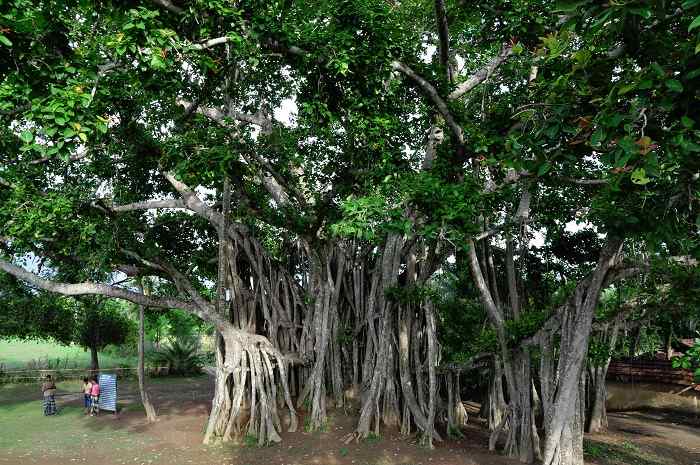
The national tree of a country is one of the symbols of pride that is integral to the nation’s identity. To be considered as such, the tree must hold tremendous cultural significance that echoes through the country’s psyche. Being native to that country adds to the privileged status of the tree to be considered as a national symbol. The national tree is an instrument of projecting certain philosophical or spiritual values, which reside at the core of the country’s heritage.
The national tree of India is the Banyan tree, designated formally as Ficus benghalensis. The tree is revered as sacred in Hindu philosophy. It is often a focal point of human establishment owing to its expansive form and shade provided. The tree is often symbol of the fabled ‘Kalpa Vriksha’ or the ‘Tree of Wish Fullfillment’ as it is associated with longevity and has important medicinal properties. The very size of the banyan tree makes it a habitat for a large number of creatures. For centuries the banyan tree has been a central point for the village communities of India. The banyan tree is massive not only from outside but it also sends new shoots from its roots, making the tree a tangle of branches, roots and trunks. The banyan tree towers magnificently over its neighbors and has the widest reaching roots of all known trees, covering several acres. The life of banyan tree is very long and is thought of as an immortal tree.
Scientific Classification
Kingdom: Plantae
Division: Magnoliophyta
Class: Magnoliopsida
Order: Urticales
Family: Moraceae
Genus: Ficus
Species: Ficus benghalensis
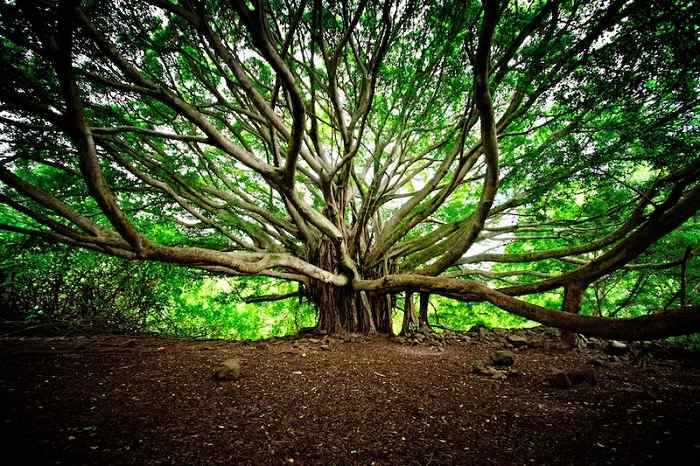
Distribution
Banyan trees are found all over tropical and sub-tropical parts of India, Pakistan and Bangladesh. They represent the largest trees in the world by canopy coverage. They occur in forest, rural as well as urban areas of the country. They often use the branches of big trees or fissures within rocks as support, ultimately taking over by destroying the supporting host. In urban areas they grow on the sides of buildings with the roots penetrating the walls and are called stranglers.
The largest banyan tree in India resides at the Indian Botanical Garden in Shibpur, Howrah in West Bengal. It is around 25 m tall and the canopy cover is around 420 m with over 2000 aerial roots.
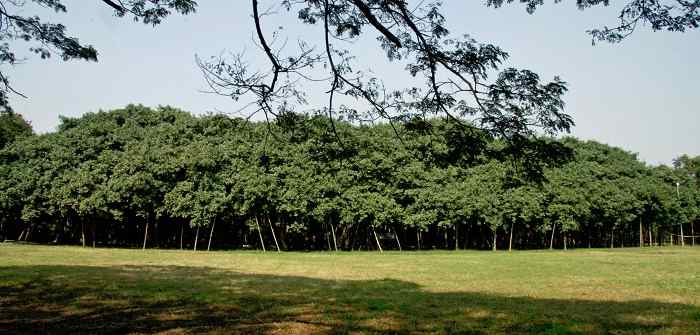
Description
Banyan trees are one of the largest trees in the world and grow up to 20-25 m with branches spreading up to 100 m. it has a massive trunk that has smooth greyish brown bark and is fluted. They have very powerful roots that can penetrate very hard surfaces like concrete and even stones sometimes. Older banyan trees are characterized by emergence of aerial prop roots that are thin and fibrous when new, but develop into thick branchlike appearance once they are old and firmly rooted onto the soil. These aerial prop roots offer support to the huge canopy of the tree. The banyan tree generally grows around an existing tree for initial support and drives it roots within it. As the banyan tree matures, the mesh of roots exerts tremendous pressure on the support tree, it eventually dies and the remains rot away leaving a hollow central column inside the main tree trunk. Leaves are thick and stout with small petioles. The leaf buds are covered by two lateral scales which fall off when the leaf matures. The leaves are glabrous on the upper surface and covered in small, fine, stiff hairs on the underside. Shape of the leaf lamina is coriaceous, ovate or orb ovate to elliptic. Dimensions of the leaves are about 10-20 cm in length and 8-15 cm in breadth. The flowers grow within a special type of inflorescence called Hypanthodium that is characteristic of Fig family trees. It is sort of a receptacle which encloses both the male and the female flowers with an opening on top known as the ostioles. The fruits of the banyan trees are types of figs that are globose to depressed-globose, 15-2.5 cm in diameter and pinkish-red in color, with some external hairs present.
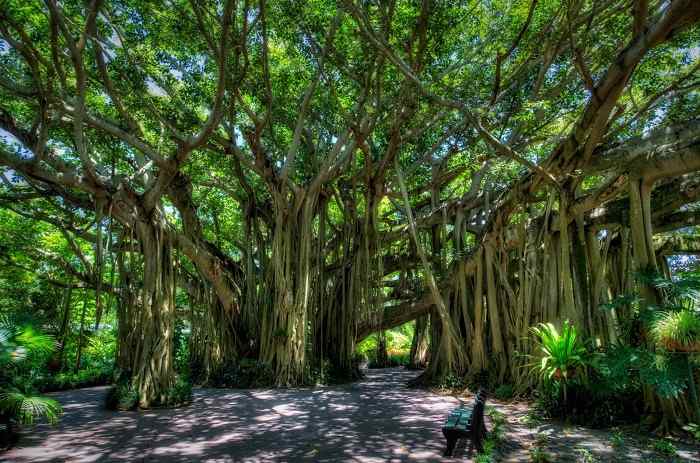
Propagation and Cultivation
The banyan tree is propagated through small birds which ingest the figs and excrete the undigested seeds. The tree begins its life as an epiphyte and often uses other mature trees as hosts. Banyan tree is propagated primarily by root tip cuttings or the eye cuttings. Initially they demand high moisture content, but once established, these trees are drought resistant. The plant may be grown indoors in a much smaller scale by a special method known as the Bonsai.
Economic value
The fruits are edible and nutritious. They are also used to soothe skin irritations and alleviate swelling. The bark and leaf extracts are used to arrest bleeding. Infusion of the leaf buds are used to treat chronic diarrhea/dysentery. Few drops of the latex help relieve bleeding piles. Young banyan tree roots are used to treat female sterility. Use of the aerial roots to clean teeth helps prevent gum and teeth problems. Application of the latex is beneficial for curing rheumatism, joint pain and lumbago, as well as to heal sores and ulcers. Infusion of barks is used to relieve nausea. The banyan tree is known to produce shellac which is used as a surface polisher and adhesive. It is produced primarily by lac producing insects that reside in the banyan tree. The milk sap is used to polish metals such as brass or copper. The wood is often used as firewood.
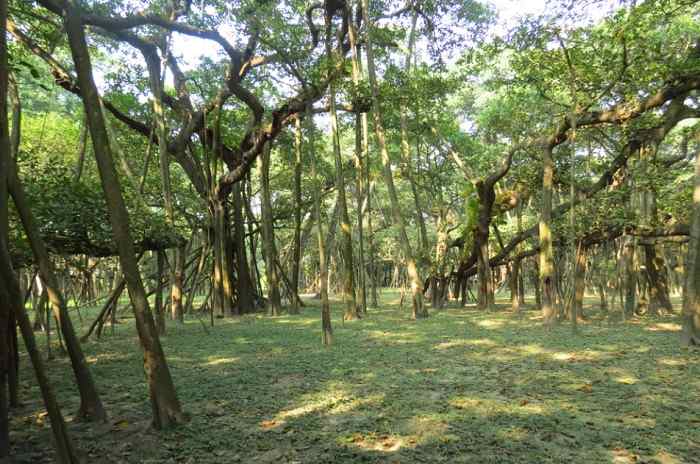
Cultural Significance
The banyan tree enjoys huge cultural importance in India. It is considered sacred among the Hindu population with temples and shrines being built under its shade quite often. Banyan tree is commonly symbolic of an eternal life as it has a very lengthy lifespan. Married Hindu women often practice religious rituals around the banyan tree to pray for long life and well-being of their husbands. The Hindu Supreme deity Shiva is often depicted as sitting and meditating under a banyan tree surrounded by sages. The tree is also considered a symbol of the Trimurti, a confluence of the three supreme deities of the Hindu mythology - Lord Brahma is represented in the roots, Lord Vishnu is believed to be the trunk and Lord Shiva is believed to be the branches. According to Buddhist beliefs, Gautam Buddha attained Bodhi by meditating under a banyan tree and the tree thus holds tremendous religious significance in Buddhism as well. The banyan tree is often the focus of a rural establishment. The shade of the banyan tree provides a soothing backdrop for peaceful human interactions. The banyan tree prevents anything from growing under its shade, not even grass. For that reason the banyan tree or its parts are considered inauspicious in cultural ceremonies like marriages.



